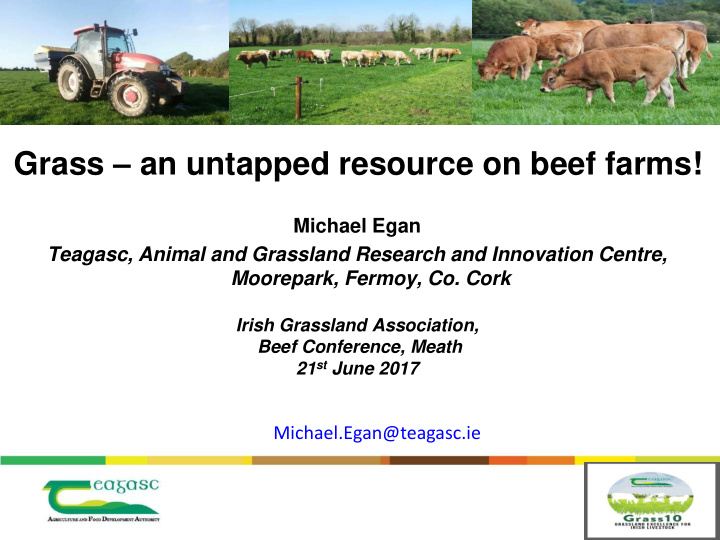



Grass – an untapped resource on beef farms! Michael Egan Teagasc, Animal and Grassland Research and Innovation Centre, Moorepark, Fermoy, Co. Cork Irish Grassland Association, Beef Conference, Meath 21 st June 2017 Michael.Egan@teagasc.ie
PastureBase Ireland Beef Farms DM Production 14 Herbage Production (t 12 10 DM/ha) 8 6 4 2 0 National farm PBI 2014 PBI 2015 PBI 2016 survey
DM Production 2016 on Drystock farms Average DM Production 12.2 t DM/ha No effect of geographic al location on grass growth!
What are the high producing farms doing? 1. Routine measurement of grass growth 2. Strong focus on soil fertility Grazing infrastructure – setting the farm up to grow grass 3. 4. Managing grass across the year 5. Routine reseeding plan
Soil fertility • Farmers aiming to grow the maximum amount of DM/ha, one of the most important components that must be correct is soil fertility • Soil pH – 6.3 • Phosphorous - Index 3 for P (5.1 – 8.1 mg/l) • Potassium - Index 3 (101 – 150 mg/l) • The most limiting factor in soil fertility will limit overall grass production Managing soil fertility is as important as managing your herd of cattle for Irish grassland farmers
Effect of soil pH on fertiliser uptake Soil pH Nitrogen Phosphorous Potassium % of utilisation utilisation utilisation fertiliser wasted 5.0-5.5 77% 48% 77% 32% 5.5-6.0 85% 52% 100% 21% 6.0-6.5 100% 100% 100% 0% • Applying 5 t/ha of lime to a soil pH of 5.3 resulted in; • increased DM production by 1.5 t DM/ha • 20% increase in stocking carrying capacity • Additional 60 units/ac of N available (2 bags of CAN)
Grazing infrastructure • Setting your farm up to grow grass is a fundamental in grassland farming • Rotational paddock grazing system • 7 – 9 paddocks per grazing group • Roadways • Paddock access points – minimum of 2 access points per paddock • Water troughs • Paddock size adequate for grazing group size • 1 ha paddock for 40 suckler cows or 55 1-2 yr olds • Paddock shape 2:1 (length: width) • Too large of paddocks results in long residency times – reduces growth
Paddock system – 20 ha farm 5+ day paddocks 3-4 day paddocks 2-3 day paddocks Being Being Being grazed grazed +25% grazed • • • Re-growths affected Re-growths somewhat Re-growths protected • • protected Difficult to graze out Increased grass growth • • • Difficult to manage in wet Reduced grass growth Increased grass utilisation • • weather Reduced animal Higher quality grass • • Moderate animal performance Increased animal • performance Hard to manage performance • • • Average pasture utilisation Contractor loves them Easy to manage surplus
Grass growth 7 15 21 30 0
Grass growth
Fencing types Two strand electric fence – Single strand electric fence – Temporary pig tail and polywire creosote posts posts • € 1.50 to € 1.70/meter • € 1.10 to € 1.20/meter • € 0.30 to € 0.40/meter • • • Very high quality High quality Temporary/easily moved • • • Low maintenance costs Medium maintenance costs Higher maintenance • Long term required • Harder changed
Spring Grazing Management 1. What happens in the first two months influences cumulative herbage production! 2. Need to finish the first rotation in early April to capture extra growth • Target April 10 th • Farms that finished the first round pre April 10 th grew 1.1 t DM/ha more grass Need to have animals out in early to mid-February to do this 3. 25000 Cumulative annual DM production (kg y = 5.8342x + 4666.4 R² = 0.668 20000 15000 DM/ha) 10000 5000 0 0 200 400 600 800 1000 1200 1400 1600 1800 2000 Spring DM production (kg DM/ha - 1 Jan to 10 April)
Grazing management × + 25 day rotation × Pre-grazing covers of >1700 kg DM/ha (>12 cm) × Poor grass utilisation (+4.5 cm) × Poor grass quality × Lower animal performance
Grazing management 18 – 21 day rotation in mid- season Pre-grazing covers of 1400 – 1600 kg DM/ha (9 – 10cm) High grass utilisation Graze swards to 4 cm residual High grass quality Increased animal performance
Reseeding • Reseeding is costly - € 250 to € 350/acre • Need to make sure it is managed well • When selecting cultivars select cultivars from the DAFM recommended list and Pasture Profit Index • White clover can have a high role on Irish beef farms • Increased grass growth • Reduced Nitrogen fertiliser application • Increased animal performance
Take home messages! 1. Soil sample farm regularly – more importantly act on results • Soil pH 6.3, Index 3 and 4 for P and K 2. Grazing infrastructure essential – every extra paddock increases grass growth and number of grazings achieved 3. Bigger focus needed on getting high quality grass for animals • Improved grassland management Better grass = increased profit €€€€€
2017 “Year of Sustainable Grassland ” Questions ?
Recommend
More recommend